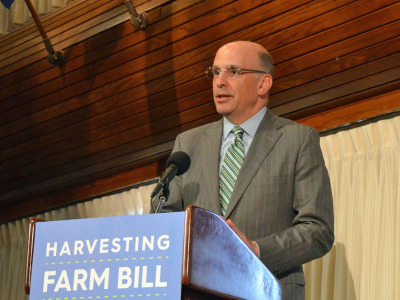Agricultural banks and farm lending institutions are optimistic about the long-term future of the farm economy, but lenders are currently in get-by mode with farmers who are struggling financially due to low commodity prices, adverse weather and ongoing trade tensions.
“Banks active in agriculture are overall healthy,” executive vice president of rural banking for Rabo AgriFinance, Curt Hudnutt told Agri-Pulse. Hudnutt said the reason most banks are healthy today is because of the Dodd-Frank Wall Street Reform and Consumer Protection Act requiring banks to increase their capitalization. Passed in 2010, the law was designed to protect consumers and prevent a repeat of the 2008 Wall Street failures.
Hudnutt said banks will start becoming concerned about their farm borrowers if commodity prices don't rebound significantly. Row-crop prices have been on the decline since 2013.
“Anything that has a large concentration of row-crop production is going to be under more stress now than other (areas),” he noted.
In Elkhart, Kan., Heartland Tri-State Bank's president and CEO, Shan Hanes, said crop prices are the top concern right now.
“We have dealt with prices really not reaching a break-even point,” Hanes said. “That is one of the things we monitor closely for our producers as we try to know their break even and what they need to get out of that crop.”
He said his bank tries to give farmers some room, but farmers still must burn through working capital, losing liquidity each year. Even though they may be making their debt payments and servicing the long-term notes, they still have less cash on hand each year.
“At some point, that is going to flip over and we can’t have that,” Hanes said.
Small rural banks heavily depend on the success of farmers because they maintain the economic vitality of the town.

Dave Coggins, Investors Community Bank
Hudnutt said banks handling livestock loans are relatively strong, but banks in the dairy sector have been weak the last 3 to 4 years.
Dairy operations make up 80% of Dave Coggins' ag portfolio at Investors Community Bank in Manitowoc, Wis., where he is the executive vice president and chief banking officer.
He said the aging demographic in the dairy sector and industry is an ongoing concern as producers continue to exit the business.
“If there’s not a good succession plan and you’ve been fighting five years of challenging milk prices, some have said now is the time,” Coggins said. He said some producers are quitting the dairy business in order to preserve their retirement savings.
From 2017 to 2018, 6.5% of dairy farms in America closed operations, according to a USDA National Agricultural Statistics Service report released in March. Wisconsin saw the biggest decline.
The recent prolonged dip in the farm economy has taken its toll on many aspects of the industry, but rural bankers say they are aware of the risks involved with financing producers in production agriculture.
“We know there is this core group of ag banks that are dedicated to keeping the economic vitality of their communities going strong,” James Chessen, chief economist at the America Bankers Association, told Agri-Pulse.
Over 1,700 banks across the country specialize in agricultural lending, according to the ABA.
Chessen said ag lending has been increasing as net farm income has declined over the last five years. Agricultural lending increased 5.3% in 2018 to $108 billion, according to an April ABA report on farm bank performance.
The trend is continuing. The second quarter of this year saw the fastest growth in the volume of non-real estate farm loans since 2011, according to the Federal Reserve Bank of Kansas City. A driving factor in the quarter's 11% increase was the growth in loans over $1 million.
The Farm Credit System, which accounts for 45% of ag lending in the U.S., is seeing the same financial conditions among its borrowers as commercial banks are.

Todd Van Hoose, Farm Credit Council
“We’re trying to get people through this the best way we can,” said Todd Van Hoose, president and CEO of the Farm Credit Council.
Several indicators such as working capital, balance sheets, and net cash income show farmers are in a tough spot right now, Van Hoose said. Working capital has been on a steady decline since 2013 even as net cash farm income has dropped from $124.5 billion that year to the $84.5 billion forecast for this year.
He pointed to tough commodity prices, problems in the dairy sector, difficulty with weather and natural disasters as contributing factors as to why farmers are having a difficult time this year.
For more news, go to www.Agri-Pulse.com.


